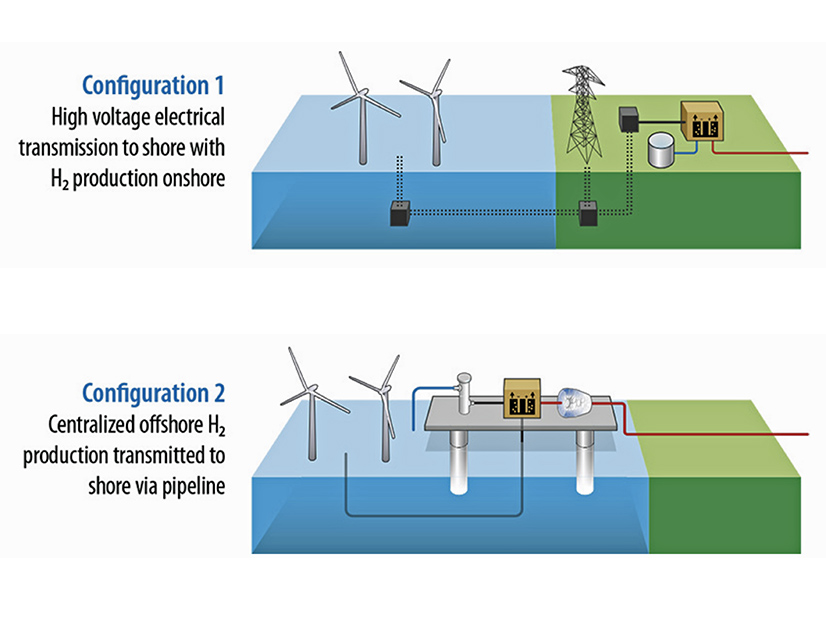
Two new reports look at the evolving economics and technologies of clean hydrogen as its potential role in the clean energy transition is debated.
Researchers at the National Renewable Energy Laboratory (NREL) conclude that using electricity from offshore wind farms to produce clean hydrogen may make economic sense, possibly lowering the cost of generation to below $2 per kilogram.
This is well above the $1/kg target set by the federal government but well below current cost of production, and possibly low enough to make it cost-competitive in some applications.
An analysis by the Clean Air Task Force (CATF), meanwhile, concludes that use of clean hydrogen for power generation would be a costly and inefficient decarbonization strategy and that hydrogen would best be prioritized as a means of decarbonizing heavy transportation and industry.
This analysis also found that using hydrogen as a form of energy storage could have some applications but likely would be less cost effective than strategies that minimize the need for long-duration energy storage, such as geothermal or nuclear.
The Biden administration has prioritized the development of clean hydrogen. It launched the Hydrogen Shot in 2021 to lower the cost from $5 to $1 per kilogram by 2031, and it designated seven regional hydrogen hubs in 2023. (See DOE Designates Seven Regional Hydrogen Hubs and DOE Hydrogen Shot Aims to Build US Supply Chain for Global Markets.)
But the rules for hydrogen tax credits it proposed seven months ago have been mired in controversy, decried as too strict by some in the energy sector and not strict enough by some clean energy advocates. (See Biden Admin. Releases Proposed Rules for Hydrogen Tax Credits.) A similar reception greeted the announcement of the hubs. (See Hydrogen Hub Announcement Draws Praise and Scorn.)
Both sides have been pushing since then to influence the final rule-making. The outcome will help determine the net environmental benefits of “green” clean hydrogen and what it costs to produce.
Offshore Wind
The NREL researchers’ article — “Potential for large-scale deployment of offshore wind-to-hydrogen systems in the United States” — was published in Journal of Physics: Conference Series and was announced July 11.
Their findings indicate the economics of producing hydrogen with offshore wind electricity would be most favorable in areas where the water is relatively shallow and the wind is relatively strong.
The levelized cost of hydrogen, which looks at the entirety of the wind, hydrogen and transmission infrastructure, would be lowest in the New York Bight and second lowest in the Gulf of Mexico, they determined.
The researchers looked at two system configurations that have been considered: a traditional setup with power exported to onshore electrolyzers that produce hydrogen from freshwater and a setup in which electrolyzers at sea produce hydrogen from desalinated seawater and send it ashore via a pipeline.
The technical feasibility of the offshore hydrogen production scenario is uncertain, the researchers said, as it would require integration of large amounts of equipment on a 250-by-250-meter sea platform.
In a news release, lead author Kaitlin Brunik, an NREL hybrid systems research engineer, said: “Both offshore wind and clean hydrogen production are technologies that are rapidly evolving and, when combined, have the potential to generate and store a lot of renewable energy and decarbonize sectors that are hard to electrify. Continued investment and research on system- and plant-level design and optimization could spur further technology progress and cost reductions for these systems.”
Production Economics
CATF announced its report, “Hydrogen in the Power Sector: Limited Prospects in a Decarbonized Electric Grid,” on July 4.
It points out the challenge of green hydrogen — to produce it in a way that does not cancel out its environmental benefits as a non-carbon fuel.
It also flags a fundamental handicap of present-day technology: It expends three-quarters of the energy potential of clean hydrogen in the process of making it. So, four units of clean energy that could be used to decarbonize the grid instead are used to create one unit of clean hydrogen.
The analysis pokes holes in the concept of using hydrogen as a power generation fuel, stating that substantial investments in storage and transmission would be needed; creating green hydrogen with electricity from renewable sources would divert that power from other decarbonization uses; producing hydrogen from natural gas with carbon capture creates significant upstream emissions associated with producing and transporting the natural gas; and the levelized cost of electrolytic hydrogen as a storage medium exceeds other options, such as pumped storage hydropower and batteries.
It adds, however, that present-day batteries are of limited duration and that hydrogen is at present one of the few technically feasible methods to convert large amounts of electricity into energy that can be stored for months.
In a news release, CATF Hydrogen Technology Director Ghassan Wakim said: “Interest in using hydrogen to decarbonize power systems has skyrocketed, specifically as a perceived ‘clean’ replacement for natural gas power plants. The superficial logic is simple: Replace a polluting fuel with one that doesn’t emit carbon dioxide. Unfortunately, the inefficiency of hydrogen production means that it either amplifies upstream natural gas emissions or diverts clean electricity that could directly decarbonize the grid instead. After a realistic assessment of clean hydrogen’s potential role in power sector decarbonization, this report finds that clean hydrogen should be prioritized for decarbonizing heavy transportation and industry, not for electricity generation.”


